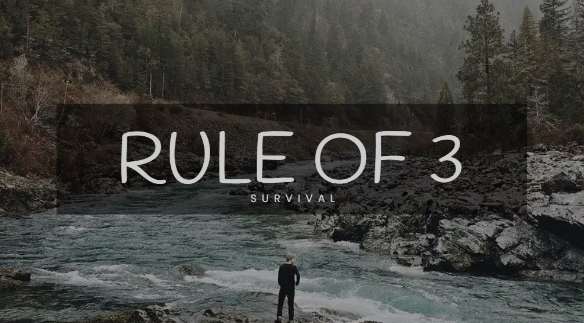The survival rule of 3 can help you prioritize your survival needs. It covers the basic survival requirements of air, shelter, water, and food. Commit this very basic rule to memory, and you’ll be able to make quick decisions about survival tasks on the fly.
Besides the rule itself, we also go over each section of the rule looking at accuracy and just what that part of the rule means for survival. There are also a few additions that have been added to the rule, and we examine those for merit.
The Survival Rule of 3
The Survival Rule of 3, or “rule of threes”, is a well-known rule of thumb that describes the basic survival rules using the number three.
The rule says that you can survive:
- 3 minutes without air
- 3 hours without shelter
- 3 days without water
- 3 weeks without food
The order of these determines what you should prioritize in a survival situation. First, you need to be able to breathe. Next, you need to have a way to shelter yourself from the elements. Then you will need to acquire a source of water. Finally, you will need to forage or hunt for food.
Each rule assumes that you are meeting the requirement above it. For example; you can’t survive 3 weeks without food unless you have water. You can’t survive 3 hours without shelter unless you have air, etc.
The survival rule of 3 may seem simplistic, but it can help you make split-second decisions in a survival situation. Mulling over whether to gather food or build a makeshift shelter can waste valuable time. The rule is simplistic so it can be easy to remember, but still helpful.
The rule is not exact. Many people can hold their breath for longer than three minutes. The shelter rule has a lot of variances based on your environmental conditions. We’ll go over each rule’s accuracy in the specific sections below.
How Long Can You Survive Without Air?
3 minutes.
You can’t make it very long without air. Oxygen is the key ingredient that we inhale, circulate through our bloodstream, and is used to power our cells. Because it is so important to our function and survival, it is important when you learn first aid. One of the first things you learn in CPR is the ABC priorities:
- Airway – Check to see if anything is blocking air from getting into the lungs, like the tongue or a foreign object.
- Breathing – Check for signs of breathing: look for chest rising, listen for breathing noises, and feel for breath movement.
- Circulation – Check for a pulse.
Air is involved in all of these- it sustains your life and any permanent interruption spells certain death.
Three minutes may not seem like a long time, but it is a general guideline. The world record for holding is a whopping 24 minutes and 3 seconds- much longer than 3 minutes! This was accomplished by Aleix Segura Vendrell, a professional free diver from Spain. Holding your breath underwater works a little differently than on land, though. Humans have a little-known reflex that makes it easier to hold their breath underwater- a reflex that helps us avoid drowning.
Drowning isn’t the only way you can die without air. Any situation that cuts off your breathing can pose a risk of immediate death- even if it seems harmless. One of the most common examples: Choking on food kills thousands of people every year. It is the fourth leading cause of unintentional injury death.
Choking is a very direct way to test how long you can survive without air. It catches you unprepared (and not underwater). Four to six minutes is about how long you have, according to medical experts. Irreversible brain death will occur within 10 minutes if you are unable to breathe or receive medical assistance.
Being prepared with CPR knowledge and knowing how to do the Heimlich maneuver is very important, according to the survival rule of 3.
Besides fluke accidents, like choking or drowning- there are several survivalist scenarios that can attack your airways. CBRN (Chemical, Biological, Radiological, and Nuclear) attacks and accidents can cause fatal damage through inhalation. N95 masks at the very least can protect you in the face of pandemics. A full-faced respirator (gas mask) with a purified air attachment (PAPR) would be the best bet for the others.
Even still, some disasters- like fire- require that you leave the area. A gas mask will not protect you from smoke inhalation. Full-service SCBA equipment is used by firefighters in these situations, and that is not practical for the public to keep it on hand.
How Long Can You Survive Without Shelter?
3 hours.
Shelter from the elements doesn’t have to be a literal bushcraft shelter. This category covers everything that stands between you and the elements, which can include:
- Tarps
- Makeshift shelters
- Bivvys
- Sleeping Bags
- Tents
- Your home
- Umbrellas
- Campfires
- Clothes
- Shoes
Exposure is the leading cause of death in the wilderness. Extreme heat and cold can be brutal on the human body, which is why we have adopted such a wide range of tools and shelters to protect ourselves.
You may not initially think of an umbrella or campfire as a type of ‘shelter’, but they definitely can protect you from the elements and, in the case of a fire, can save your life.
Similarly, clothes are a barrier between your body and the elements. On the popular survival series, Naked and Afraid, contestants have to strip down for the survival challenge. This doesn’t just add awkward drama that makes for good TV- it also makes it more difficult to survive. Contestants have to figure out how to keep a fire going, huddle for warmth, and even ward off insects. This added curveball is one reason why it ranked so high on our top survival TV show list.
You may need to get creative yourself if you are needing shelter in a survival situation and have no equipment. Bushcraft is one of the leading wilderness survival hobbies, and it covers building shelters in the wild. One of the best YouTube channels demonstrating this is Primitive Technology, which takes it one step further by using only primitive tools for bushcraft:
https://www.youtube.com/watch?v=P73REgj-3UE&t=2s
How Long Can You Survive Without Water?
3 days.
Thirst is uncomfortable. Dehydration is painful. And beyond that? Fatal.
Going without water can quickly become a life-threatening problem. This makes sense because our bodies are mostly water. Most people know that we are made up of about 60% water, but this varies quite a bit by organ:
- Brain = 73% water
- Lungs = 83% water
- Muscles = 79% water
- Skin = 64% water
- Bones = 31% water
Babies are especially watery- being over 78% water. Women are about 5% less water than men, on average as well! So what happens when we cut off this elixir of life? Bad stuff happens.
The body’s thirst mechanism lags behind dehydration- so by the time you are thirsty, your body is already feeling some effects. Slight dehydration affects your mood, memory, attention span, and coordination. Then your kidneys start to retain water, reducing your urge to urinate. From this point forward, your blood starts to thicken with less water, and your cardiovascular system can become stressed: lightheadedness and even fainting will occur. Quickly after this, organs can begin shutting down.
Your level of activity and the environment around you can greatly affect how long you can go without water. Extreme temperatures can make your body require more water- especially if you are active.
There is a wide range of guidance on how much water you need each day to survive, but the most sponsored guidance from doctors and scientists is about half a gallon each day (2 Liters). They say this should be stretched out in 8 servings of 8-ounce cups (8×8) so that you have a steady supply of water throughout the day.
Scientists have also said that the average time a human can last without water is closer to 100 hours (a little over 4 days), as opposed to 3 days. This is assuming room temperature in a lab setting. High heat will drastically cut this down below two days. Cold weather can extend this beyond 5 days.
Supply interruptions and utility shutoffs are a few of the ways large groups of people could start running short of water. With a water shortage, unique collection methods will come in handy, such as capturing and filtering your own water, rainwater collection, and distilling from the air.
How Long Can You Survive Without Food? 3 weeks.
Hunger can be brutal, but starvation is deadly. Although it is the last priority for the survival rule of 3, food is still important and on the list. Even though our bodies can tolerate long periods without food, it can be one of the more difficult things to find in an emergency or disaster situation.
Supply chain interruptions can sever food sources from their destination across any country. The modern world is powered by supermarkets that rely on these delicate supply chains, and variances in either demand or supply are quickly seen.
A food storage plan is very important for prepping and survival. There are many methods, from methodically stashing canned goods in your pantry to picking up new hobbies- like trapping.
Variations of the Survival Rule of 3
The rule seemed a little too basic to some because a few have tacked on some extra variations/rules to ‘spice it up.’ I’m not partial to over-complicating a simple rule, but you can decide for yourself. A few extra ‘rule of threes’ include:
You can survive:
- 3 seconds before making a survival decision
- 3 minutes in icy water
- 3 months without companionship
- 3 months without hope (also have seen this as 3 seconds)
The bullet about hope is a throwback to the saying:
“Man can live 40 days without food, three days without water, eight minutes without air, but only one second without hope.”
This is less catchy and harder to remember than the survival rule of threes, and I’m not completely sold on the ‘hope’ part. Although I agree hope is important in a survival situation, it is less tangible than the other requirements for the human body.
These extra rules are less concrete and the whole thing gets further away from the original intent as you add more rules. I prefer the original, simple Survival Rule of 3- but feel free to chime in with any additions that you prefer in the comment section.
The Final Word
The survival rule of 3 is a great rule to lean on when you need to make a split-second decision during a disaster or emergency. It is also a good rule of thumb to plan around when developing prepping and survival kits. It gives us foundational survival values and sound risk management in an easy-to-remember ‘rule’.
After learning why you need to prepare for emergencies, we can help you with what. You can find our kit guides in the top menu for specific disaster kit recommendations, or you can start with our general survival kit which covers most of the bases at home.
Beyond these guides, we also test and recommend a wide variety of tried-and-true equipment for a wide range of budgets. This should help you on your way to preparedness and improve your survivability with all four sections of the survival rule of 3.
Keep exploring, stay prepared, and be safe.
surce: https://trueprepper.com/survival-rule-of-3/
Terms of Use:The information presented on the network is intended to expand personal knowledge and provide general understanding in a variety of fields to help you be active your Creative freedom and nurturing your health. The information presented here does not pretend to be and is not a substitute for medical instructions. Everything presented on the network is the personal opinion of the writers and any decision regarding your action or health choice is your sole responsibility. with regards For complete inner freedom.
Outhematrix (out the matrix) Network management.







